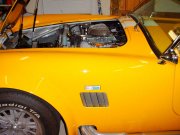The Mr.2 with its center mass is an interesting car. I watched one in my rear view mirror spin a number of times on and off the highway as part of an accident. It spun within its wheelbase, not something a front or rear engined car would do.
(apologies in advance to Spence & his quest for Muse Model 1 preamp info... :0)
Agreed. It's true that
where we position the weight in a chassis will have a direct effect on how fast it can rotate when external forces and/or driver input exceeds traction limits. Just like the
ice skater modulating their spin speed via hand/arm placement:

This all reminds me of when I used to tinker with 5-Liter Mustangs in the '80s. You would install the Ford Motorsports spring lowering kit (~3/4") and combine that with either Bilstein or adjustable Koni struts/shocks. Stickier tires than stock. Then a strut tower brace across the top and a K-frame brace across the bottom to better keep the suspension geometry from being all out of whack when maneuvering said flexible flyer.
And the result? The car was certainly more responsive/more of a driver's car, but ultimately at the limits the communication between car & driver boiled down to: (paraphased) "I'll never let go. I'll never let go. I'll never let go ---
Yo! I just let go! :0)
Time passes, Mustang is swapped out for a pair of used Infinity speakers & a $250 '78 Fiesta commuter car. More cow bell, less tire squalling.
Life is hunky dory.
More time passes. My buddy Paul talks me into building/co-owning a FF Cobra replica. During the entire build, in the back of my mind was the unsettling thought that we were putting together an even faster car that would share that nonlinear behavior at the limits...
But as it turned out, thankfully the Cobra was very linear/communicative at/near the limits. I know that we reduced the overall weight significantly while maintaining pretty much the same size tire contact patches, but that didn't explain it all. Finally, this picture gave me a clue:

Stock length (aluminum Ford Motorsports) Mustang driveshaft on left. Custom-length driveshaft for FF Cobra on right.
[Driveshaft model is Paul's son Bradley.]
So, on the old 5-Liter Mustangs the engine is parked between the front tires. (The stock oil pan actually has 2 sumps/2 drain plugs in order to help the engine oil pan clear the K-member.) On the Cobra, not only is the wheelbase shorter, but the engine is completely
behind the front crossmember -- I seem to remember the harmonic balancer is ~2" behind the Cobra's front crossmember:

Engine setback photo. Note: Light blue upper radiator hose connects near front of Windsor 302.
Also, the powerplant's center of gravity is improved by aluminum heads & intake plus lightweight tubular exhaust. Aluminum-cased T-5 trans + aluminum bellhousing also helps:

With V2.0 of the powerplant we even lost 12 more lbs (24 lb cast iron stock) by adopting an aluminum flywheel:

(Best 12 lbs lost to date -- engine now brought more 'drama' to the driving experience...more immediacy, dynamics, inner detail, etc. :0)
****
I know, we changed a whole handful of variables between the lower polar moment of inertia, lighter engine/lower center of gravity, and over a 1,000 lbs total vehicle weight...but the net result was that the Cobra was very communicative & linear as I approached the grip limits. As a matter of fact the car's limits were > than my own. (As opposed to the Mustang, where on more than one occasion I nearly ripped the seat cushion from surprise extra-pucker-factor moments. :0)
Of course, even if I optimize the weight distribution I can still depart controlled flight if I decide to completely ignore the laws of physics. You can use a hammer to build a house, or destroy a Stradivarius. My plan is to never, ever find out just how fast that the Cobra can spin within it's wheelbase...
:0)
****
Spence, I think that I can salvage this posting. Obviously, for improved center of gravity with your Muse preamp, you are going to want to put that 40-lb power supply
below the main box instead of
above it. Keep the power/weight ratio as high as you can afford to go -- when it comes to audio, Speed Thrills! Horsepower numbers may move cars off of the showroom floor, but torque is really where it's at 100% of the time you are driving around town...the country...or the track. :0)
Cheers --
3D





